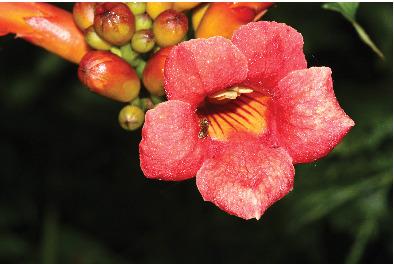当前位置:
X-MOL 学术
›
Ecol. Entomol.
›
论文详情
Our official English website, www.x-mol.net, welcomes your feedback! (Note: you will need to create a separate account there.)
Bees provide pollination service to Campsis radicans (Bignoniaceae), a primarily ornithophilous trumpet flowering vine
Ecological Entomology ( IF 2.2 ) Pub Date : 2020-09-12 , DOI: 10.1111/een.12947 Byron N. Van Nest 1, 2 , Andrea A. Edge 3 , Michael V. Feathers 1 , Anne C. Worley 2 , Darrell Moore 1
Ecological Entomology ( IF 2.2 ) Pub Date : 2020-09-12 , DOI: 10.1111/een.12947 Byron N. Van Nest 1, 2 , Andrea A. Edge 3 , Michael V. Feathers 1 , Anne C. Worley 2 , Darrell Moore 1
Affiliation

|
Pollination syndromes refer to stereotyped floral characteristics (flower colour, shape, etc.) that are associated with a functional group of pollinators (bee, bird, etc.). The trumpet creeper Campsis radicans, endemic to the southeast and mid‐west United States, has been assigned to the hummingbird‐pollination syndrome, due mainly to its red, trumpet‐shaped flowers. Previous studies demonstrated that the ruby‐throated hummingbird Archilochus colubris is C. radicans' primary pollinator, but anecdotal data suggest various bee species may provide pollination service when hummingbirds are absent. This study characterised C. radicans nectar volume and concentration by time of day. Nectar volume was suitable for hummingbirds, but concentration was higher than typical hummingbird‐pollinated plants (∼20% w/w); at ∼30% w/w, it approached the concentration expected in bee‐pollinated plants (∼50% w/w). We also found substantial amounts of nectar at night. Two C. radicans populations received virtually no hummingbird visits, but the number of bees were markedly higher than in the populations previously described. Interestingly, there were no night‐time visitors despite the large quantity of nocturnal nectar. Based on previously published pollen delivery per visit by various species, this study estimated that cumulative deposition by bees routinely reached pollen deposition thresholds for setting fruit in C. radicans. They are, unequivocally, the predominant pollinators in these populations, thus providing pollination service in the absence of hummingbirds. These results highlight C. radicans as a food source for native bees and add to the understanding of how floral phenotypes can facilitate pollination by disparate functional groups.
中文翻译:

蜜蜂为 Campsis radicans (Bignoniaceae) 提供授粉服务,这是一种主要的亲鸟小号开花藤本植物
授粉综合症是指与授粉者功能群(蜜蜂、鸟类等)相关的刻板花卉特征(花色、形状等)。美国东南部和中西部特有的小号爬山虎 Campsis radicans 已被归类为蜂鸟授粉综合征,主要是因为它的红色喇叭状花朵。先前的研究表明,红喉蜂鸟 Archilochus colubris 是 C. radicans 的主要传粉者,但传闻数据表明,当蜂鸟不存在时,各种蜜蜂物种可能会提供授粉服务。该研究按一天中的时间对 C. radicans 花蜜量和浓度进行了表征。花蜜量适合蜂鸟,但浓度高于典型的蜂鸟授粉植物(~20% w/w);约 30% w/w,它接近蜜蜂授粉植物中预期的浓度(~50% w/w)。我们还在夜间发现了大量的花蜜。两个 C. radicans 种群几乎没有蜂鸟访问,但蜜蜂的数量明显高于先前描述的种群。有趣的是,尽管有大量的夜间花蜜,但没有夜间游客。根据先前公布的不同物种每次访问的花粉递送,本研究估计蜜蜂的累积沉积通常达到在 C. radicans 中结出果实的花粉沉积阈值。毫无疑问,它们是这些种群中的主要传粉媒介,因此在没有蜂鸟的情况下提供传粉服务。这些结果突出显示了 C。
更新日期:2020-09-12
中文翻译:

蜜蜂为 Campsis radicans (Bignoniaceae) 提供授粉服务,这是一种主要的亲鸟小号开花藤本植物
授粉综合症是指与授粉者功能群(蜜蜂、鸟类等)相关的刻板花卉特征(花色、形状等)。美国东南部和中西部特有的小号爬山虎 Campsis radicans 已被归类为蜂鸟授粉综合征,主要是因为它的红色喇叭状花朵。先前的研究表明,红喉蜂鸟 Archilochus colubris 是 C. radicans 的主要传粉者,但传闻数据表明,当蜂鸟不存在时,各种蜜蜂物种可能会提供授粉服务。该研究按一天中的时间对 C. radicans 花蜜量和浓度进行了表征。花蜜量适合蜂鸟,但浓度高于典型的蜂鸟授粉植物(~20% w/w);约 30% w/w,它接近蜜蜂授粉植物中预期的浓度(~50% w/w)。我们还在夜间发现了大量的花蜜。两个 C. radicans 种群几乎没有蜂鸟访问,但蜜蜂的数量明显高于先前描述的种群。有趣的是,尽管有大量的夜间花蜜,但没有夜间游客。根据先前公布的不同物种每次访问的花粉递送,本研究估计蜜蜂的累积沉积通常达到在 C. radicans 中结出果实的花粉沉积阈值。毫无疑问,它们是这些种群中的主要传粉媒介,因此在没有蜂鸟的情况下提供传粉服务。这些结果突出显示了 C。


























 京公网安备 11010802027423号
京公网安备 11010802027423号